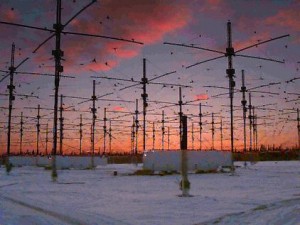HAARP as Described by the European Parliament in 1999
Source: European Parliament
 Report on the environment, security and foreign policy (14 Feb 1999)
Report on the environment, security and foreign policy (14 Feb 1999)
HAARP – a weapons system which disrupts the climate
On 5 February 1998 Parliament’s Subcommittee on Security and Disarmament held a hearing the subject of which included HAARP. NATO and the US had been invited to send representatives, but chose not to do so. The Committee regrets the failure of the USA to send a representative to answer questions, or to use the opportunity to comment on the material submitted.(21)
HAARP (High Frequency Active Auroral Research Project) is run jointly by the US Air Force and Navy, in conjunction with the Geophysical Institute of the University of Alaska, Fairbanks. Similar experiments are also being conducted in Norway, probably in the Antarctic, as well as in the former Soviet Union.(22) HAARP is a research project using a ground based apparatus, an array of antennae each powered by its own transmitter, to heat up portions of ionosphere with powerful radio beams.(23) The energy generated heats up parts of the ionosphere; this results in holes in the ionosphere and produces artificial ‘lenses’.
HAARP can be used for many purposes. Enormous quantities of energy can be controlled by manipulating the electrical characteristics of the atmosphere. If used as a military weapon this can have a devastating impact on an enemy. HAARP can deliver millions of times more energy to a given area than any other conventional transmitter. The energy can also be aimed at a moving target which should constitute a potential anti-missile system.
The project would also allow better communications with submarines and manipulation of global weather patterns, but it is also possible to do the reverse, to disrupt communications. By manipulating the ionosphere one could block global communications while transmitting one’s own. Another application is earth-penetrating, tomography, x-raying the earth several kilometres deep, to detect oil and gas fields, or underground military facilities. Over-the-horizon radar is another application, looking round the curvature of the earth for in-coming objects.
From the 1950s the USA conducted explosions of nuclear material in the Van Allen Belts(24) to investigate the effect of the electro-magnetic pulse generated by nuclear weapon explosions at these heights on radio communications and the operation of radar. This created new magnetic radiation belts which covered nearly the whole earth. The electrons travelled along magnetic lines of force and created an artificial Aurora Borealis above the North Pole. These military tests are liable to disrupt the Van Allen belt for a long period. The earth’s magnetic field could be disrupted over large areas, which would obstruct radio communications. According to US scientists it could take hundreds of years for the Van Allen belt to return to normal. HAARP could result in changes in weather patterns. It could also influence whole ecosystems, especially in the sensitive Antarctic regions.
Another damaging consequence of HAARP is the occurrence of holes in the ionosphere caused by the powerful radio beams. The ionosphere protects us from incoming cosmic radiation. The hope is that the holes will fill again, but our experience of change in the ozone layer points in the other direction. This means substantial holes in the ionosphere that protects us.
With its far-reaching impact on the environment HAARP is a matter of global concern and we have to ask whether its advantages really outweigh the risks. The environmental impact and the ethical aspect must be closely examined before any further research and testing takes place. HAARP is a project of which the public is almost completely unaware, and this needs to be remedied.
HAARP has links with 50 years of intensive space research for military purposes, including the Star Wars project, to control the upper atmosphere and communications. This kind of research has to be regarded as a serious threat to the environment, with an incalculable impact on human life. Even now nobody knows what impact HAARP may have. We have to beat down the wall of secrecy around military research, and set up the right to openness and democratic scrutiny of military research projects, and parliamentary control.
A series of international treaties and conventions (the Convention on the prohibition of military or any other hostile use of environmental modification techniques, the Antarctic Treaty, the Treaty on principles governing the activities of states in the exploration and use of outer space including the moon and other celestial bodies, and the UN Convention on the Law of the Sea) casts considerable doubt on HAARP on legal as well as humanitarian and political grounds. The Antarctic Treaty lays down that the Antarctic may be used exclusively for peaceful purposes.(25) This would mean that HAARP is a breach of international law. All the implications of the new weapons systems should be examined by independent international bodies. Further international agreements should be sought to protect the environment from unnecessary destruction in war.
Read the complete report : European Parliament

